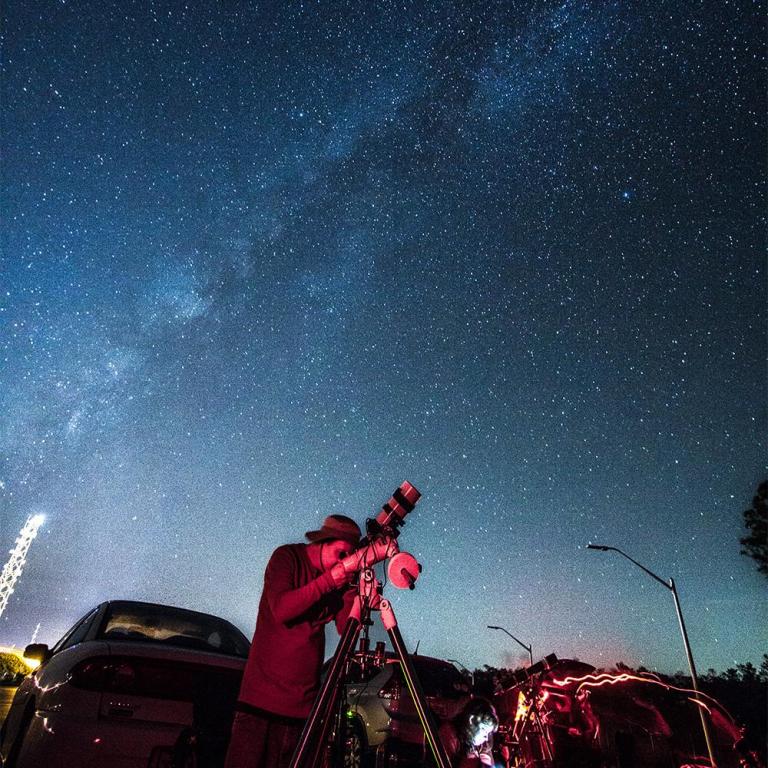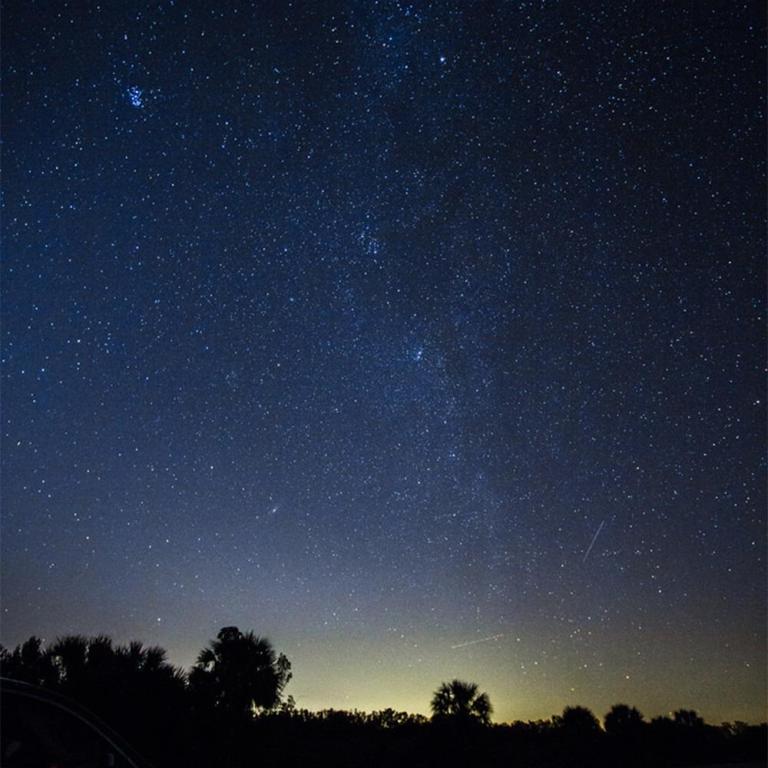What to See in the Big Cypress Night Sky: A Stargazer’s Calendar

Plan a visit to Big Cypress National Preserve on a clear night, and you’ll see something that’s becoming increasingly rare: a night sky full of stars, unspoiled by city lights. This massive stretch of protected land in South Florida is one of the darkest spots east of the Mississippi, and it was officially recognized as an International Dark Sky Park in 2016.
For stargazers, that means you can find some of the best dark sky views around within the preserve. And the best part? What you see changes throughout the year! Different constellations, meteor showers, and even galaxies come into view depending on the season.
With this in mind, we put together this comprehensive guide on what to expect when visiting Big Cypress after dark. No matter when you plan your trip, there’s always something exciting happening in the night sky!

Winter
(December-February): The Clearest Nights of the Year
If you’re wondering what the best time of year for stargazing is in Big Cypress National Preserve, many people would say winter (coinciding with the dry season). While you won’t be able to see the center of the Milky Way during this season, you can expect more comfortable temperatures, clearer skies, and excellent visibility for constellations.
For example, you can identify Orion the Hunter easily, thanks to his three-star belt. Taurus and Gemini reach peak visibility in the winter, as well as Sirius, the brightest star in the night sky. There are also two exciting meteor showers you won’t want to miss during this time of year: the Geminids meteor shower in mid-December and the Quadrantids peak in early January.
Of course, another big reason to plan your visit to Big Cypress during the winter is the ranger-led astronomy programs. The park holds these events once a month, treating visitors to free constellation tours and talks led by staff and local astronomers. They’re a great way to start learning about everything you can see in the dark skies! After the program finishes, don’t miss the chance to check out the telescopes local astronomy clubs set up close to the welcome center.

MM 63, December 2014, Big Cypress National Preserve
Spring
(March-May): Galaxy Season
Spring brings warmer temperatures—and as Earth’s position changes— amateur astronomers and astrophotographers welcome a special time of year called “galaxy season.” Leo takes center stage in early spring, with its signature Sickle asterism forming the lion’s mane as well as the chance to spot the three galaxies that make up the Leo Triplet: M66, M65, and NGC 3628. Virgo then follows, which you can usually locate by looking for Spica, the brightest object in the constellation.
March often marks Big Cypress’s final astronomy event of the season. The reserve typically hosts an early spring program—often in collaboration with local astronomers—that includes telescope viewing and an educational talk. You won’t want to miss it if you’re in town!
Finally, April brings the Lyrid meteor shower, one of the oldest known meteor showers. It peaks around April 22 and can be best viewed around midnight into dawn.

Seagrape Drive, March 2014, Big Cypress National Preserve
Summer
(June-August): Best Time to See The Milky Way
If you want to see the Milky Way in all its glory, summer is the best time to visit Big Cypress National Preserve. While Florida in the warmer months means more humidity (and more mosquitoes), you can also expect longer evenings and some of the best visibility of the Galactic Center.
If you’re having trouble finding the Milky Way, you’ll want to look between the constellations Scorpius and Sagittarius. Sagittarius, in particular, tends to be easier for beginner stargazers to identify in the sky, thanks to its teapot shape!
For those visiting in mid-August, you have the chance to see one of the best meteor showers of the year: the Perseids. This meteor shower features bright and abundant shooting stars with long “wakes” and sometimes even the occasional fireball.
Unfortunately, Big Cypress doesn’t usually offer ranger-led astronomy programs during the summer months. However, it’s still a great time to plan a solo or family stargazing session! Just don’t forget a few essentials: bug spray, water, and a red-light flashlight.
Fall
(September-November): Dark-Sky Season Begins Again
Fall welcomes the return of cooler temperatures, longer nights, and clearer skies, making it another great time for stargazing at Big Cypress. It’s also when the Andromeda Galaxy, the closest major galaxy to our own Milky Way, is visible to the naked eye on clear and moonless nights.
Constellations like Pegasus and Cassiopeia reach peak visibility, and their V-shaped and W-shaped formations are fun to find in the night sky. Around mid-October, you can attempt to view the Orionid meteor shower! Although it’s not quite as intense as the Perseids meteor shower, the brighter meteors should still be visible.
Remember that the ranger-led astronomy programs in Big Cypress do not officially resume until December. Nonetheless, fall is still a great time to plan a stargazing visit without the crowds.
Enjoy the Night Sky Throughout the Year
No matter when you decide to visit Big Cypress National Preserve, there’s always something waiting to be discovered in the night sky. From the center of the Milky Way to exciting meteor showers, both amateur astronomers and experienced astrophotographers won’t want to miss this International Dark Sky Park. For once-in-a-lifetime night skies, ONLY Paradise will do.